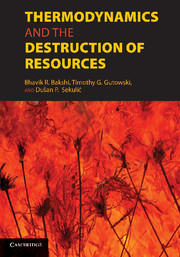Book contents
- Frontmatter
- Contents
- Contributor List
- Foreword by Herman E. Daly
- Foreword by Jan Szargut
- Preface
- Introduction
- PART I FOUNDATIONS
- PART II PRODUCTS AND PROCESSES
- PART III LIFE-CYCLE ASSESSMENTS AND METRICS
- PART IV ECONOMIC SYSTEMS, SOCIAL SYSTEMS, INDUSTRIAL SYSTEMS, AND ECOSYSTEMS
- Appendix: Standard Chemical Exergy
- Index
Preface
Published online by Cambridge University Press: 01 June 2011
- Frontmatter
- Contents
- Contributor List
- Foreword by Herman E. Daly
- Foreword by Jan Szargut
- Preface
- Introduction
- PART I FOUNDATIONS
- PART II PRODUCTS AND PROCESSES
- PART III LIFE-CYCLE ASSESSMENTS AND METRICS
- PART IV ECONOMIC SYSTEMS, SOCIAL SYSTEMS, INDUSTRIAL SYSTEMS, AND ECOSYSTEMS
- Appendix: Standard Chemical Exergy
- Index
Summary
This book is intended to bring together a wide range of theoretical and experimental results from many different disciplines, all addressing sustainability issues using thermodynamic arguments. The disciplines involved include mechanical and chemical engineering, physics, economics, geography, ecology, and industrial ecology. The contributors from Japan, Europe, and the United States are all to some extent speaking one language, albeit with different applications, construction of arguments, and degree of rigor.
We believe that it is time for a book like this to introduce the fundamentals and applications of thermodynamics to demonstrate the richness and broad applicability of thermodynamic principles and the essential role that it can play in quantifying the impact of human activities on natural resources and the environment. Our goal has been to assemble a collection of chapters written by authorities in their own fields who share thermodynamics-inspired approaches to a diverse set of topics. Although there are many obstacles to presenting all of these different areas in a unified way, we believe we have succeeded in bringing together in one book a glimpse of the breadth of applications that can be considered from a thermodynamic perspective. Different chapters keep quite visible the flavor of a particular discipline, although some cross-fertilization and trans-disciplinary approaches to the issues are demonstrated. So, our ultimate goal has evolved into a promotion of the use of a rigorous science/engineering discipline (thermodynamics) not to solve problems beyond its realm but to assist in understanding the problem at hand, to define well the system considered, to implement conservation principles, and to appropriately merge such an approach with other disciplines.
- Type
- Chapter
- Information
- Thermodynamics and the Destruction of Resources , pp. xxi - xxiiPublisher: Cambridge University PressPrint publication year: 2011



